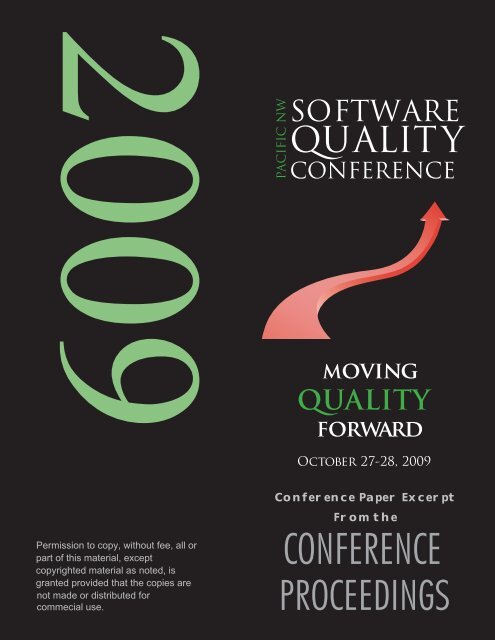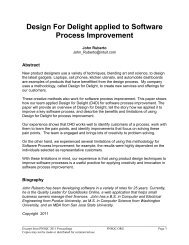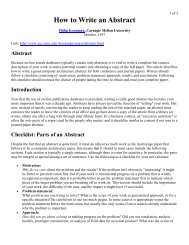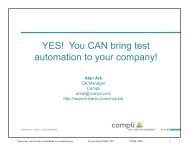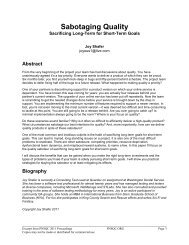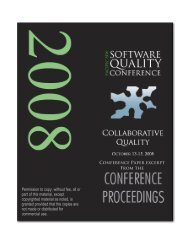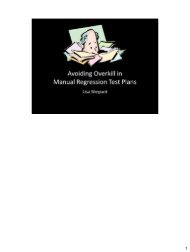Too much automation or not enough? - PNSQC
Too much automation or not enough? - PNSQC
Too much automation or not enough? - PNSQC
- No tags were found...
Create successful ePaper yourself
Turn your PDF publications into a flip-book with our unique Google optimized e-Paper software.
Both being software, they are both likely to have defects resulting in the unexpected result beingobserved. See Examples of Automated and Manual analysis f<strong>or</strong> further discussion.3.1 Capture/ReplayA frequent, but sometimes dangerous way to change from manual tests looking f<strong>or</strong> latent defects intoautomated tests looking f<strong>or</strong> regressions is to rec<strong>or</strong>d the manual test in some fashion and then be able touse that rec<strong>or</strong>ding as a way to repeat <strong>or</strong> replay the test. This can be done at any level, code, UserInterface (UI), protocol on the wire communication, etc. This maj<strong>or</strong> issue is the assumption that a manualtest should be transf<strong>or</strong>med into an automated test. Many latent defect repeating. Their value in finding a latent defect was perhaps marginal and repeating them provides evenless incremental value.Given that automating a test is m<strong>or</strong>e expensive than running a test manually, which regression tests toautomate should <strong>not</strong> default to all of the attempts made at finding latent defects.4 Manual vs. Automated testsHuman versus computer execution is emphasized in Manual tests can also be frequently described less exactly than automatedtests. To have an automated test, it must ultimately result in code executable by a computer, and mostinstructions to computers today are fairly exacting with f<strong>or</strong>mal syntax and rules, whether a scriptinglanguage such as Ruby <strong>or</strong> Powershell, <strong>or</strong> a compiled language such as Java <strong>or</strong> C#. Automated testsusing keyw<strong>or</strong>d <strong>or</strong> action w<strong>or</strong>d <strong>automation</strong> elevates the abstraction language, but is still ultimately turnedinto a detailed sequence by software.4.1 Expl<strong>or</strong>at<strong>or</strong>y TestsManual tests may have only broad charters that employ expl<strong>or</strong>at<strong>or</strong>y techniques of concurrent iterativeplan, design, execution, and evaluation of test ideas. Expl<strong>or</strong>at<strong>or</strong>y testing is effectively only possible todayusing humans doing some f<strong>or</strong>m of manual testing. Some types of testing are best done using expl<strong>or</strong>at<strong>or</strong>ytesting. Usability testing in terms of how humans perceive an interface generally requires humans. Youcan perhaps use automated tests to verify user interface guidelines, but <strong>not</strong> necessarily usability.4.2 Scripted TestsThe other f<strong>or</strong>m of manual testing can be called scripted testing that describes step by step procedures.Still the level of detail of the steps can vary widely. It might be high level and loose, f<strong>or</strong> example:<strong>or</strong>LoginEnter username and passw<strong>or</strong>dOr low level and very tight such asClick mouse in username field to pClick mouse in passw<strong>or</strong>d field to pClick on login buttonThe second script is approaching the level of detail eventually required f<strong>or</strong> an automated test (although anautomated test might also have high level methods likeLoginEnteringUsernameAndPassw<strong>or</strong>d(string username, string passw<strong>or</strong>d)This results in execution similar to the detailed script.The first script allows the human, manual tester, a great degree of freedom in how to approach the task.They can choose the method of entry: keyboard sh<strong>or</strong>t cuts? Tabbing to fields? Using the mouse?They can choose the data to enter: if multiple usernames with passw<strong>or</strong>ds are available they can usedifferent ones at different times.______________________________________________________________________________Excerpt from <strong>PNSQC</strong> 2009 Proceedings5 of 11<strong>PNSQC</strong>.ORG
Automated Failure Analysis is a means of determining if a specific observed failure has previously beendiagnosed. Why Weak Automation Is W<strong>or</strong>se Than NoAutomationreally strikes home.A<strong>not</strong>her example is verifying UI output. Frequently min<strong>or</strong> variances in UI can be critical <strong>or</strong>inconsequential. Computers have a difficult time distinguishing. Computers can easily distinguish ifsomething is different, but <strong>not</strong> the significance of the difference. So one example of <strong>automation</strong> is toautomatically rec<strong>or</strong>d differences (analysis) and later provide humans the ability to manually evaluate theirsignificance (rep<strong>or</strong>ting).7 ConclusionHow are you repeating your test? Manually via humans <strong>or</strong> automated via software?Software test <strong>automation</strong> is merely a method of repetition. When to automate software testing isdependent on many fact<strong>or</strong>s mostly around repetition.When are you repeating your tests? How often? Every input value <strong>or</strong> combination of inputs? Every day<strong>or</strong> once a year? The m<strong>or</strong>e you repeat the m<strong>or</strong>e likely <strong>automation</strong> makes sense.Why are you repeating your tests? Change to the inputs, environment, <strong>or</strong> software? Changing the inputsrequires an understanding of what the expected outputs will be. F<strong>or</strong> UI testing, a human can sometimesm<strong>or</strong>e quickly and easily judge if the expected output looks right. F<strong>or</strong> changing environment and softwareyou are usually expecting the same output, and automated tests are typically m<strong>or</strong>e reliable at detectingchanges.What are you repeating about your tests? What are you varying? Repeating the same inputs makes<strong>automation</strong> m<strong>or</strong>e likely. Varying an environment may be expensive and difficult and thus only manuallydone. Repeatedly using the same SUT means you are looking f<strong>or</strong> latent defects, <strong>not</strong> regressions, andexpl<strong>or</strong>at<strong>or</strong>y testing may be most valuable.8 ReferencesBergman M., and K. Stobie, 1992 How to Automate Testing-the Big Picture, Quality Week 1992http://keithstobie.net/Documents/TestAuto_The_BigPict.pdfDustin, E., et al 1999, Automated Software Testing: Introduction, Management, and Perf<strong>or</strong>mance,Addison-Wesley Professional 1999. ISBN: 978-0201432879Gamma, E., et al 1994, Design Patterns: Elements of Reusable Object-Oriented Software, Addison-Wesley Professional, 1994 ISBN: 978-0201633610Hoffman, D. 1999, Cost Benefits Analysis of Test Automation, Proceedings of the Software TestingAnalysis and Review Conference (STAR East). Orland, Fl<strong>or</strong>ida. May 1999http://www.softwarequalitymethods.com/Papers/Star99%20model%20Paper.pdfKaner, C., J. Bach and B. Pettich<strong>or</strong>d. 2001, Lessons Learned in Software Testing, Wiley 2001Marick, B. 2000, Testing F<strong>or</strong> Programmers, (pages 43-47)http://www.exampler.com/testing-com/writings/half-day-programmer.pdfMarick, B. 1999, http://www.exampler.com/testing-com/writings/testers-upstream.pdfMarick, B. 1998, When Should a Test Be Automated?, Quality Week 1998http://www.exampler.com/testing-com/writings/automate.pdf______________________________________________________________________________Excerpt from <strong>PNSQC</strong> 2009 Proceedings10 of 11<strong>PNSQC</strong>.ORG
Mosley, D. and B. Posey 2002, Just Enough Software Test Automation, Prentice Hall PTR, 2002.ISBN: 978-0130084682Saran, c 2008, Autistic people prove valuable in software testing, ComputerW<strong>or</strong>ld, 15 Feb 2009,http://www.computerweekly.com/Articles/2008/02/15/229432/autistic-people-prove-valuable-in-softwaretesting.htmStaneff, G., 2007, Test Logging and Automated Failure Analysis, SASQAG September 2007.http://www.sasqag.<strong>or</strong>g/pastmeetings/9-2007/SASQAG_9-20-2007.pptTravison, D. and Staneff, G. 2008, Test Instrumentation and Pattern Matching f<strong>or</strong> Automatic FailureIdentification, 1st International Conference on Software Testing, Verification, and Validation, 2008ISBN: 978-0-7695-3127-4Whittaker, J. 2002, How to Break Software: A Practical Guide to Testing, Addison Wesley 2002ISBN: 978-0201796193______________________________________________________________________________Excerpt from <strong>PNSQC</strong> 2009 Proceedings11 of 11<strong>PNSQC</strong>.ORG


